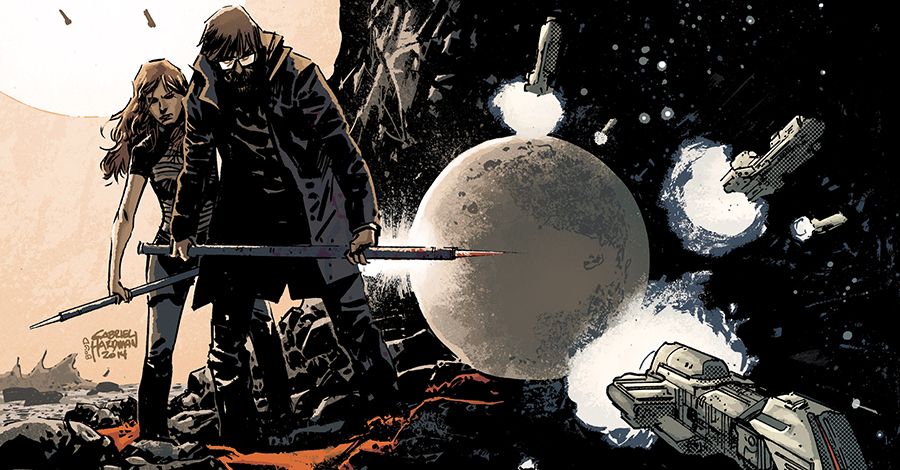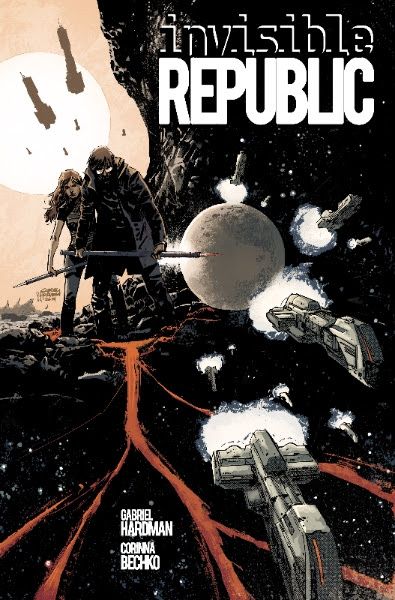More and more artists and writers are venturing into the creator-owned realm of comic books. At the "Image Comics is Everything" panel this past weekend at Long Beach Comic Con, creators Gabriel Hardman, Corinna Bechko, Chris Burnham, Marc Bernardin, Ken Kristensen, Alec Siegel writer Kyle Higgins gathered to discuss their experiences with the cutting edge publisher.
Moderator Albert Ching, Managing Editor for Comic Book Resources, started by asking the panelists about their current projects.
Hardman cited the collected edition of his Monkeybrain Comics series "Kinski" (which he described as a "Coen Brothers-esque" story), "Invisible Republic" with Bechko and two unnamed projects would be coming out in the near future.
Burnham teamed up again with writer Grant Morrison on a "really weird" horror comic called "Nameless." The book is a departure from what he's used to drawing in superhero comics where the artist stated the focus is on clarity and dynamism. "But when you're working on a horror book, clarity isn't always the object," said Burnham. "I've never really worked this way, so I'm having an interesting time figuring out how to make conversations look weird." He said he couldn't offer much detail beyond the name and its sci-fi/horror nature, but he did say their joke working title was "At The Meteors of Madness."
Bernardin said that in the six years since he and co-writer Adam Freeman began "Genius," "the world kind of exploded" -- and what he saw on the news was similar to their story of a teenage tactical genius uniting several gangs in three blocks of South Central Los Angeles and forcefully seceding.
"[It] was both amazing and horrifying all at the same time," said Bernardin. "But the reception was pretty good and Top Cow was pretty happy. Everyone seemed pleased, so we're going to do another mini-series which hopefully will drop in the middle of next year."
Kristensen said that Todd, in the third arc of "Todd, The Ugliest Kid on Earth," tries to join the Boy Scouts. "His parents won't pay for the uniforms," said Kristensen, "so he inadvertently joins Joseph Kony's child army in the Congo." There's also a "meta-fictional" spinoff mini-series of "The Albanian," the fictional TV show in "Todd" coming from Image next year.
Siegel and Higgins' "C.O.W.L" started out as a short film that they co-wrote and Higgins directed. Higgins described the 1960s union-of-superheroes-fighting-changing-times comic as "'The Wire' meets 'Mad Men' meets 'The Avengers' -- I guess." Issue #6 tells the origin story of one of the main characters, drawn in the style of Jack Kirby, or a comic from 1962. "There's going to be old '60s ads that we're designing," said Higgins. "I think we're actually going to do a mail thing, you cut out the ad and fill it out and send it to a P.O. Box."
"It's actually interesting how where the story ended in the first arc is kind of the point we've talked about since we made the short film," Siegel said. "We talked about it...and we planned it out. So now it's kind of very exciting and scary as we're going into uncharted territory."
When asked why they thought it was a special time for Image and creator-owned comics, Higgins related his experience working at big comic book companies. "I came up through Marvel and DC, and writing those characters is a dream come true for me, but at the same time there's a level of respect that you have to pay -- not only to what came before but what could come later down the line. So the characters can be in a very safe place, they maintain their status quo. Far smarter people than me have described it as all second act stories -- the illusion of change...you write that stuff for a long enough time and you want to try something else. Image is the...most creative freedom, and [gives] the most support for material that creators are passionate about."
"I think also, in a broader cultural way, people are maybe getting a little bit tired of hearing stories that have been told before," Hardman added. "Not just as far as superhero comics or Marvel and DC and stuff like that, I think that it's something that's kind of percolating up. Just having these same stories constantly regurgitated is maybe running its course a little bit. And comics are often a place where different ideas bubble up and manage to make their way in earlier than somewhere where you have to spend millions and millions of dollars to make something. It's cheap to make comics and it's an accessible medium and it's someplace where people can get...new, different ideas out in an economical way."
The discussion turned to broadening audiences, which Bernadin called "The Walking Dead Affect" -- when a show based on a comic book gets people interested in reading the comics, and then they find other books that may interest them. Kristensen said Image publisher Eric Stephenson had a lot to do with "the tide rising."
"I think he's the smartest publisher in comics, no offense to other publishers in the audience," said Kristensen. "He has this vision, he's got taste like nobody else, he's open to every genre, he's open to taking risks on books that other publishers pass on."
Questions from the audience were focused on the process of managing a creator-owned title, including world building and story development, balancing independent and contract work, and keeping up with the schedule. Burham said it took less energy to write in an established world versus building your own, though both had their difficulties.
"Creatively, they're different muscles," said Higgins. "When I work on stuff for Marvel or for DC, I'm working in service for my editor, who is working in service for his editors or editor-in-chief. You do the best you can to tell the story you're passionate about and it's a collaboration... Logistically, I'll be honest, I would not have been able to launch 'C.O.W.L.' had I not been writing Batman. There is a name cache there, there is a promotional benefit to having written bigger works at DC...The hope is that a portion of the readership follows."
"If you're creatively engaged in still writing a Batman story, it's not a bad thing to do it if you have that opportunity," Higgins continued. "Both worlds can coexist. And the other thing logistically is that creator-owned books, the onus is on the creators to get them off the ground financially and also logistically. Launching one of these things is hard. It takes a lot of resources, so having a work for hire job that also helps supplement you is a very real facet of this." He also said that paying an artist was very important since it took on average six weeks to draw the book, and asking them to defer getting paid for two months wasn't fair.
On the topic of plotting out storylines, Bernardin said, "If you're creating an ongoing story, the foundation is the most important thing. You have to have the right pieces in place that allow you this sort of infinite variation. Like if you look at 'The X-Files,' you have Mulder who's all about faith, Scully's all about science, then you have Skinner who's all about the bureaucracy, and then you have the mythology. You've got these four different story engines and you can begin to throttle one up and pull one back, adjust and combine differently so that you can spin that story for a long time. Because your characters are strong, your fundamentals are strong, and that allows you to tell a story that's two years, or five years, or ten years, because all those pieces are in place."
Ching asked Bernardin whether the sequel to "Genius" was already planned or if it was developed recently. "We always had an idea of the ways the stories could go, the levers we could push to make it interesting," he said. "The challenge for us is a way to tell a story that reminds you of the first one but isn't a carbon copy of the first one. You don't want to do a sequel that takes everything away from it that people liked, but you also don't want to do the same thing. So we're looking at it, in a totally humble way, as trying to do 'The Wire.' Which is, again not at all setting myself up for failure, but finding a way to tell stories that feel thematically similar but have completely different story drives and locations and themes, but still feel of the piece."


